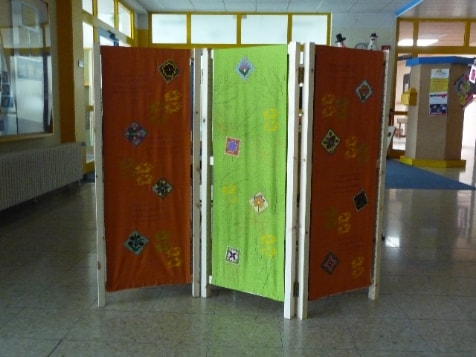Various projects
at Rupert-Mayer-Schule,
Spaichingen
Afghan embroidered squares as a starting point for projects in textile design classes
At the Catholic Free Primary and Secondary School, Rupert-Mayer-Schule in Spaichingen, home economics and textile design are important aspects of the curriculum. Boys and girls start using sewing machines in year six and can continue up to year ten. However it is mainly girls who choose this specialty beyond year eight, most boys prefer technology. I like offering projects involving the embroidered squares to year eight and nine students. I buy the squares with proceeds from sewing courses for colleagues and parents. We always start the project with information about Afghanistan – the country, the geographical location, climate, political situation – and then we introduce Pascale Goldenberg`s embroidery project. Her travel reports and photographs on the homepage are particularly valuable. Over the past few years I have prepared four different projects, some of them have been run repeatedly.
Project 1: Wall hangings on stretcher frames
Log cabin technique is used for framing the embroidery squares. Additionally, a block pattern of the same seize is created for each block using various surface design techniques. Depending on the seize and number of blocks, quilts are assembled, quilted with the sewing machine and then mounted on a stretcher frame.
Project 2: Folding screens with screen-printing and squares
To create the various parts of the folding screen, suitable fabrics are hemmed and screen-printed using stencils, then the squares are appliquéd. We use the side sections of wooden shelving for the partitions of the folding screen, joining them with hinges. The fabric is attached to the wooden frame with Velcro strips.
Project 3: Bags – jeans-recycling
Back part and straps of the bag are cut from an old pair of jeans, preferably including the back pocket. The front of the bag is made with an embroidery square surrounded by log cabin or crazy patch patterns.
Project 4: Cushion cover with crazy-patch or log cabin pattern
An embroidery square is set in crazy-patch or log cabin pattern for the front of the cushion cover, preferably using fabrics dyed by the students (a lesson in colour theory), the back of the cushion cover closes like an envelope.
text and photographs by Jutta Höss
Translated into English by Solveigh Goett





























